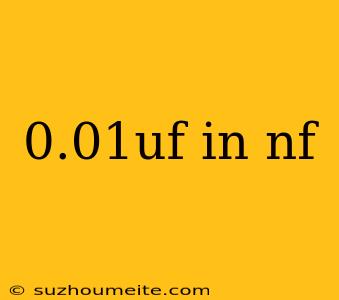Understanding 0.01uF in NF: A Comprehensive Guide
When working with electronic circuits, capacitors play a crucial role in filtering, coupling, and decoupling signals. Capacitance values are often expressed in units of Farads (F), but what does 0.01uF in NF mean? In this article, we'll delve into the world of capacitance units and explore the meaning behind 0.01uF in NF.
What is uF?
uF is an abbreviation for microfarads, which is a unit of capacitance. One microfarad is equal to one-millionth of a farad (10^-6 F). Capacitors with values in the range of microfarads are commonly used in electronic circuits for various applications, including filtering, coupling, and decoupling.
What is NF?
NF is an abbreviation for nanofarads, which is a smaller unit of capacitance. One nanofarad is equal to one-billionth of a farad (10^-9 F). Capacitors with values in the range of nanofarads are typically used in high-frequency circuits, such as radio frequency (RF) and microwave circuits.
0.01uF in NF: Conversion
Now, let's convert 0.01uF to NF. Since one microfarad is equal to 1000 nanofarads, we can convert 0.01uF as follows:
0.01uF = 0.01 × 1000 = 10NF
So, 0.01uF is equivalent to 10NF.
Practical Applications of 0.01uF Capacitors
Capacitors with a value of 0.01uF (or 10NF) are commonly used in various applications, including:
- Audio circuits: 0.01uF capacitors are used as coupling capacitors in audio circuits to block DC voltage while allowing AC signals to pass through.
- Radio frequency (RF) circuits: 0.01uF capacitors are used as tuning capacitors in RF circuits to adjust the frequency of oscillation.
- Electromagnetic interference (EMI) filtering: 0.01uF capacitors are used as decoupling capacitors to filter out high-frequency noise and electromagnetic interference in digital circuits.
Conclusion
In conclusion, 0.01uF in NF is equivalent to 10NF, which is a relatively small capacitance value. Capacitors with this value are commonly used in various applications, including audio circuits, RF circuits, and EMI filtering. By understanding the conversion between microfarads and nanofarads, engineers and technicians can accurately select the right capacitor values for their specific applications.
